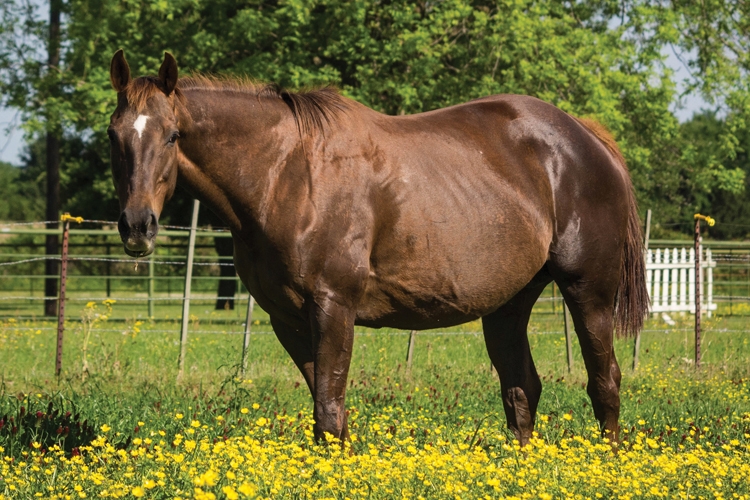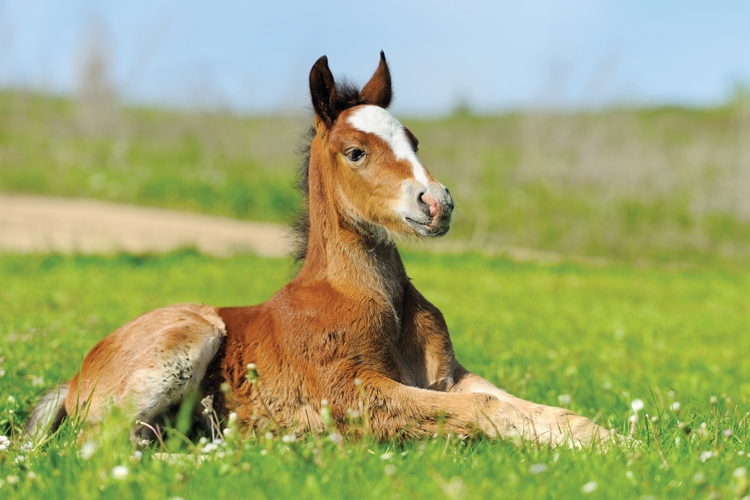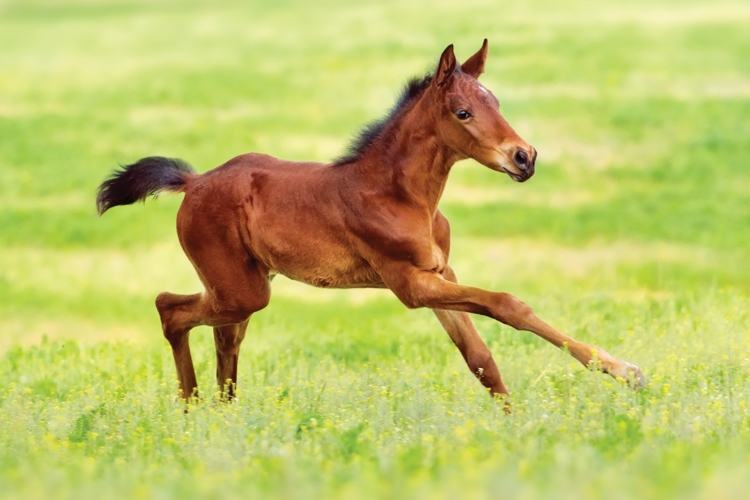
Joint Health for Long Term
To develop the best racing prospect, you may have your own breeding program or you may purchase a youngster from selected mare and stallion combinations. The decisions you make in combining mare and stallion have a definite influence on the robustness of the offspring’s musculoskeletal system. Selecting both the mare and stallion for strong conformational attributes can improve known structural deficits in either individual. Research on the history of siblings and offspring helps to evaluate the potential outcome of this breeding. Performance history of mare, stallion, and offspring also colors your decision. Despite some notable imperfections in musculoskeletal structure, many equine athletes still are able to perform successfully.
Fetal Development
Balanced nutrition of the broodmare is important from conception to birth of a growing fetus with the potential to affect the occurrence of developmental orthopedic disease (DOD) in young horses. Developmental orthopedic disease is usually multifactorial in origin, affected by nutrition, conformation, and environmental factors as well as heritable characteristics. DOD encompasses many musculoskeletal problems including epiphysitis, flexural limb contractures, angular limb deformities, osteochondrosis (defects in joint cartilage), and cervical vertebral stenosis (wobbler) syndrome.
Intake quantity and ratios of certain minerals (zinc, copper, calcium and phosphorus) are important for proper cartilage maturation in joints, particularly in the mare’s last trimester. Since mare’s milk is a poor source of trace minerals, a foal depends on liver mineral stores, such as copper, for several months following birth. Copper contributes to mineralization of the cartilage matrix and bone development. While a foal’s liver store of copper has no influence on the incidence of DOD, it plays a role in improvement and repair of potential DOD lesions.
Foal Growth
Rather than a smooth continuum or steady, progressive increase in size, a foal’s growth includes growth “spurts.” Ideally, you’ll want to avoid fueling rapid or excessive growth through close observation and management of a foal’s caloric intake. What the mare eats during lactation affects her milk production. Consumption of abundant, rich milk prompts growth spurts in her foal. Intake of excessive feed has more of an impact on musculoskeletal concerns than inadequate feed. DOD lesions in young horses are linked to excess calories and energy.
For the first 2-3 months of life, the foal derives the bulk of its nutrition from the mare’s milk. By a few weeks of age, a foal begins to sample and consume some of the mare’s food. With this in mind, whatever feed the dam receives also affects the foal. Caloric intake is a more important consideration than protein concentration – studies have not associated any problem with high dietary levels of protein. In fact, adequate protein (14-16% of the foal’s total diet) is important for proper bone development. Protein restricted to less than 12% is correlated with reduced growth rates and poor bone and cartilage mineralization. Most importantly, excessive energy (such as found in grains, rich pasture and high sugar foods) can “fuel” excessive growth and subsequent abnormalities associated with improper endochondral ossification of joint cartilage.
As with the gestating mare, mineral balance is critical to proper musculoskeletal development of the growing foal, particularly of calcium-phosphorus and copper-zinc ratios. Many commercial feeds intended to support growing foals have appropriate balances of minerals and essential components to achieve the objective of steady growth. If you have any uncertainty about what to feed, consult with your veterinarian.
Exercising the Growing Foal
Exercise management is important for the young, rapidly growing horse, and is best coupled with a balanced ration. Articular cartilage of the joints needs normal use and weight bearing to optimize its development. Exercise is good for a growing foal, but keep in mind that excesses can lead to problems.
It is equally important not to impose limitations to exercise of a growing youngster since loading of the limbs promotes proper development of bone and soft tissue of the growing skeleton. Studies have shown that foals receiving controlled exercise as they grow have fewer joint injuries than horses not worked until they are two years old.
A study at Colorado State University looked at six youngsters conditioned from birth until 18 months of age and compared them to six youngsters only given pasture turnout. Using computed tomography (CT scan) and histology (microscopic study) of the fetlock joints, the researchers discovered that the foals “exercised since near birth had fewer gross lesions in the joints, greater bone fraction in the dorsolateral (front outside) aspect of the condyle (rounded protuberance at the end of the bone), and higher bone formation rate compared to non-exercised horses.” Cartilage of joint surfaces responds favorably to appropriate location and duration of loading by producing extracellular matrix (proteoglycans) that enhances the ability to successfully manage weight-bearing loads. The conclusion is that there is a net benefit of early exercise to young joints.
For foals at risk of DOD, complete restriction of exercise doesn’t guarantee complete prevention of DOD. However, avoiding excessive exercise strain is important to reduce joint trauma that can result in growth plate abnormalities or formation of subchondral bone cysts.
Loading that occurs with normal weight bearing and light turnout exercise may promote acceptable cartilage development, particularly in the early months of foal growth. As the foal develops and ages, moderate exercise with gradual increases in intensity and duration results in better cartilage health and fewer injuries than that imposed by sudden, high intensity loading. For a young horse in training, find a middle ground of voluntary and controlled training.
Longeing and round pen work are commonly used training techniques early on but such circle work can be counterproductive to a healthy skeleton, especially if a young horse carries on without appropriate restraint. It’s probably better to hold off on circle work until at least the yearling stage, or even longer. There’s evidence that articular cartilage responds in a ‘handed’ fashion – if a young horse works in one direction more than another, cartilage development can differ between limbs. Avoid repetition in early exercise – repetition, such as incurred by constant circle work, is challenging not only to joints but to tendon, ligament and muscle, as well. Instead of attempting to use the round pen or longe line as a conditioning and training venue, just familiarize the young horse with short sessions of circle work.
For a young horse with early signs of DOD – joint and/or limb swelling, slight or overt lameness, limb angle deviation from normal and/or limb flexural deformity (‘contraction’) – exercise should be controlled, reduced or even stopped altogether and veterinary consultation sought promptly.
Joint Injury of All Ages: The Importance of a Proper Diagnosis
Prevention of injury is the primary objective to long-term joint health in all ages. For the grown horse in training, good body weight and body condition score along with muscle strength are important goals. Additionally, condition the horse for the specific exercise demands he is asked to perform. There is also great value in cross training, i.e. work the horse in a variety of athletic pursuits, such as trail riding, arena work, and cavalleti exercises. This is good not just for body development but also for a horse’s mental engagement.
In the event of an injury, rapid detection is important. Seek veterinary attention at first notice of abnormal clinical signs, such as swelling, heat, pain, and/or lameness. Joint effusion (excess fluid) is typically the first abnormal sign seen after joint injury. In some cases, changes are subtle, as for instance a horse doesn’t perform up to expectations. A steady decline in performance associated with gait changes or a horse’s reluctance to perform expected athletic efforts is cause for concern. The earlier a joint insult is recognized and treated, the better the expected result.
It is sometimes tempting to ignore inconsistencies in a horse’s performance but continued exercise on even mildly injured tissue can create a long and frustrating course of disease progression and treatment. Rather than trying to “work the horse through it,” stop exercise and contact your veterinarian for an evaluation. Local application of cold (water and/or ice) early after joint injury is helpful to stem inflammation. It’s best to withhold administration of NSAIDs (phenylbutazone, flunixin, firocoxib) until speaking with your veterinarian. NSAIDs are invaluable at decreasing inflammation, but their ability to mask pain can confuse examination findings.
To improve a horse’s athletic outcome, accurate assessment of joint injury is essential to develop an appropriate treatment plan. A thorough physical and lameness examination by your veterinarian helps narrow the concerns to a specific joint(s). Additional diagnostic tools further define the injury: regional anesthetic nerve blocks, joint fluid assessment, radiography, ultrasonography, nuclear scintigraphy and MRI. Returning joint anatomy and function to normal is the primary goal, and this relies on an accurate diagnosis and appropriate therapeutic regimen.



